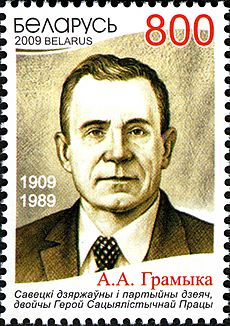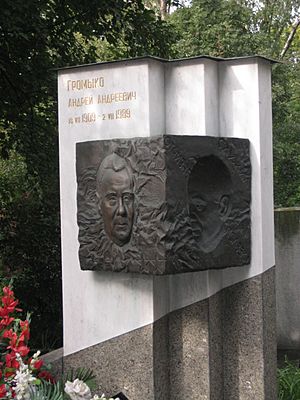Andrei Gromyko facts for kids
Quick facts for kids
Andrei Gromyko
Андрей Громыко |
|
|---|---|

Gromyko in 1972
|
|
| Chairman of the Presidium of the Supreme Soviet | |
| In office 27 July 1985 – 1 October 1988 |
|
| Deputy | Vasili Kuznetsov Pyotr Demichev |
| Preceded by | Konstantin Chernenko Vasily Kuznetsov (acting) |
| Succeeded by | Mikhail Gorbachev |
| First Deputy Chairman of the Council of Ministers of the Soviet Union |
|
| In office 24 March 1983 – 2 July 1985 |
|
| Premier | Nikolai Tikhonov |
| Preceded by | Heydar Aliyev |
| Succeeded by | Nikolai Talyzin |
| Minister of Foreign Affairs | |
| In office 15 February 1957 – 2 July 1985 |
|
| Premier | Nikolai Bulganin Nikita Khrushchev Alexei Kosygin Nikolai Tikhonov |
| Preceded by | Dmitri Shepilov |
| Succeeded by | Eduard Shevardnadze |
| Permanent Representative of the Soviet Union to the United Nations | |
| In office April 1946 – May 1948 |
|
| Premier | Joseph Stalin |
| Preceded by | Post created |
| Succeeded by | Yakov Malik |
| Full member of the 24th, 25th, 26th, 27th Politburo of the Communist Party of the Soviet Union | |
| In office 27 April 1973 – 30 September 1988 |
|
| Personal details | |
| Born |
Andrei Andreyevich Gromyko
18 July [O.S. 5 July] 1909 Staryye Gromyki, Mogilev Governorate, Russian Empire (now Gomel, Belarus) |
| Died | 2 July 1989 (aged 79) Moscow, Russian SFSR, Soviet Union |
| Resting place | Novodevichy Cemetery, Moscow |
| Nationality | Soviet |
| Political party | Communist Party of the Soviet Union (1931–1989) |
| Spouse |
Lydia Grinevich
(m. 1931) |
| Children | Anatoly and Emiliya |
| Profession | Economist, diplomat, civil servant |
Andrei Andreyevich Gromyko (Russian: Андрей Андреевич Громыко; Belarusian: Андрэй Андрэевіч Грамыка; 18 July 1909 – 2 July 1989) was an important Soviet politician and diplomat. He played a big role during the Cold War, a time of tension between the Soviet Union and Western countries.
Gromyko served as the Minister of Foreign Affairs from 1957 to 1985. This meant he was in charge of how the Soviet Union dealt with other countries. Later, he became the Chairman of the Presidium of the Supreme Soviet from 1985 to 1988. This was a largely ceremonial role as the head of state.
Because he often used the Soviet Union's veto power in the United Nations Security Council during the 1940s, people in the West called him Mr Nyet (which means "Mr No"). He was responsible for many key decisions about Soviet foreign policy until he retired in 1988.
Gromyko's political career began in 1939. He became the Soviet ambassador to the United States in 1943. After that, he was the Soviet Permanent Representative to the United Nations in New York. He also served as the Soviet ambassador to the United Kingdom in 1952.
As Foreign Minister, Gromyko was involved in major events like the Cuban Missile Crisis. He also helped create peace between India and Pakistan after their war in 1965. Under Soviet leader Leonid Brezhnev, Gromyko helped improve relations with the United States. This period was called détente, meaning a reduction in tensions. He helped negotiate important agreements like the ABM Treaty and the SALT I & II treaties, which aimed to limit nuclear weapons.
Gromyko's conservative views and distrust of Western countries shaped Soviet foreign policy for a long time. This continued even after Brezhnev's death, until Mikhail Gorbachev became leader in 1985. After Gorbachev took power, Gromyko was given a less powerful role and retired from politics in 1988. He passed away the next year in Moscow.
Contents
Early Life and Education
Growing Up in Belarus
Andrei Gromyko was born on 18 July 1909, in a small village called Staryye Gromyki in Belarus. His family was poor, with his father working in a factory and his mother helping with farm work. Both his parents had very little schooling.
Gromyko grew up in a religious village. However, he started to question religious beliefs at a young age. He learned about new ideas from a neighbor who was a freethinker. After the Russian Revolution, when he was nine, Gromyko began reading materials that promoted atheist and Communist ideas. By age thirteen, he joined the Komsomol, a youth organization, and gave speeches about communism in his village.
In August 1914, when Germany attacked the Russian Empire, Gromyko felt a strong sense of love for his country. His father joined the army and fought for three years. After Vladimir Lenin died in 1924, Gromyko, as the local Komsomol leader, assured villagers that the Communist Party would continue Lenin's work.
School and Joining the Party
Gromyko's mother encouraged him to get an education. He finished seven years of primary school and vocational training in Gomel. Then, he moved to Borisov to attend a technical school. In 1931, Gromyko joined the Communist Party of the Soviet Union. He had wanted to join since he learned about the differences between rich and poor. He often volunteered his time for party work.
While studying in Borisov, Gromyko met Lydia Grinevich, who would become his wife. Lydia came from a peasant family in Belarus. They had two children, Anatoly and Emiliya.
After two years, Gromyko became the principal of a secondary school in Dzerzhinsk. He taught there and continued his own studies. Later, he was offered a chance to do advanced studies in economics in Minsk. He accepted and moved his family there in 1933.
In 1934, Gromyko and his family moved to Moscow. By 1936, he became a researcher and lecturer at the Soviet Academy of Sciences. He specialized in the US economy and wrote several books about it. In 1939, because many positions in the diplomatic service became open, Gromyko was chosen to work in diplomacy. He was transferred from the Academy of Sciences to the diplomatic service.
Becoming a Diplomat
Ambassador During World War II
In early 1939, Gromyko started working for the People's Commissariat for Foreign Affairs in Moscow. He became the head of the Americas department. In this role, he met with the United States ambassador.
Soon after, Joseph Stalin, the Soviet leader, told Gromyko that he would be sent to the Soviet embassy in the United States as the second-in-command. Stalin emphasized the importance of good relations with the US, especially with the growing threat of fascist countries. Stalin even suggested Gromyko listen to sermons in American churches to improve his English, though Gromyko never did.
Gromyko had never traveled abroad before. He flew through several European countries to Genoa, Italy, and then took a ship to the United States. He later wrote that New York City showed how wealth and technology could create something "totally alien to our nature." He also saw the working districts as proof of the unfairness of capitalism.
In 1943, Gromyko became the Soviet ambassador to the United States. He admired President Franklin D. Roosevelt, even though he saw him as representing the wealthy class. During his time as ambassador, Gromyko met famous people like actor Charlie Chaplin.
Gromyko was part of the Soviet delegations at important wartime meetings, including the Tehran, Dumbarton Oaks, Yalta, and Potsdam conferences. In 1943, he was also appointed Soviet ambassador to Havana, Cuba. When he returned to Moscow after the Soviet victory in World War II, Stalin praised him, saying a good diplomat was "worth two or three armies at the front."
Leading Soviet Foreign Policy
At the United Nations
In April 1946, Gromyko became the Permanent Representative of the Soviet Union to the United Nations (UN). The UN is an international organization that aims to promote peace and cooperation. Gromyko often used the Soviet Union's veto power in the UN's early days. This meant he could block resolutions in the United Nations Security Council. Because of this, he earned the nickname Mr Nyet ("Mr No"). In the first 10 years of the UN, the Soviet Union used its veto 79 times.
Gromyko believed that the first two UN Secretary-Generals, Trygve Lie and Dag Hammarskjöld, supported policies that were against the Soviet Union. He was told by a later Secretary-General, U Thant, that it was hard to have an unbiased view of the USSR within the UN because many staff members were American or supported the US.
Ambassador to the United Kingdom
In June 1952, Gromyko was appointed Soviet ambassador to the United Kingdom. Joseph Stalin told him that the UK had a chance to play a bigger role in world politics. Gromyko met with Winston Churchill in 1952 and 1953, mostly to talk about their experiences during World War II. He returned to Russia when he was made Deputy Minister of Foreign Affairs.
Foreign Minister of the Soviet Union
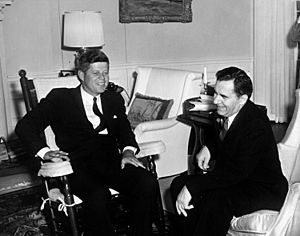
As Minister of Foreign Affairs, Gromyko spent a lot of time dealing with other parts of the Communist Party that tried to interfere with his work. He didn't like this power sharing.
One of his first big challenges came in 1958. Mao Zedong, the leader of China, asked the Soviet Union to support his plan for war with the Republic of China. Mao even said he was willing to sacrifice "300 million people." Gromyko told him that the Soviet leadership would never agree. After this, Moscow stopped its nuclear program and other projects with China.
During the Cuban Missile Crisis, Gromyko met with U.S. President John F. Kennedy. Gromyko later wrote that Kennedy seemed nervous. Gromyko defended the Soviet Union's actions, pointing out that the US had placed its own missiles in Turkey. He felt it was unfair to blame the Soviet Union for its presence in Cuba when America had many military bases worldwide.
Under Leonid Brezhnev, Gromyko played a key role in creating détente, a period of reduced tensions between the Soviet Union and the United States. He helped sign important agreements like the Treaty on the Non-Proliferation of Nuclear Weapons in 1968, the ABM and SALT I treaties in 1972, and the Agreement on the Prevention of Nuclear War in 1973. Gromyko believed that "Disarmament is the ideal of Socialism."
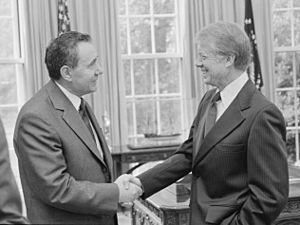
Gromyko always believed that no important international agreement could happen without the Soviet Union's involvement. He was proud of the Partial Nuclear Test Ban Treaty. In 1966, he and Alexei Kosygin helped Pakistan and India sign a peace treaty after their 1965 war. He also met with Pope Paul VI, which led to more openness for the Roman Catholic Church in Eastern Europe.
In 1973, Gromyko became a full voting member of the Politburo, the Soviet Union's highest decision-making group. As he gained more power, his diplomatic style became less flexible. He was known for his excellent memory and confidence.
When Brezhnev became ill in 1975, Gromyko, along with the head of the KGB and the Defense Minister, largely controlled Soviet policy. Even after Brezhnev's death, Gromyko's strong distrust of the West continued to shape Soviet foreign policy.
After Konstantin Chernenko became leader, Gromyko took even more control over diplomacy. He often interrupted Chernenko in front of other world leaders. Despite Chernenko wanting to improve relations, Gromyko's distrust of the West made it difficult.
In 1985, Gromyko nominated Mikhail Gorbachev to be the new General Secretary. Once Gorbachev was elected, he replaced Gromyko as foreign minister with Eduard Shevardnadze. Gromyko was then given the mostly honorary position of Chairman of the Presidium of the Supreme Soviet.
Head of State, Retirement, and Death
As Chairman of the Presidium of the Supreme Soviet, Gromyko's role was mainly ceremonial, and his influence decreased. While some journalists thought he was uncomfortable with Gorbachev's reforms, Gromyko wrote positively about Gorbachev and his policy of perestroika (restructuring). He believed perestroika was about building a socialist society and saw glasnost (openness) as an effort to make the USSR more democratic.
In July 1988, a party member called for Gromyko's resignation, blaming him for the country's economic problems. After discussing it with his wife, Gromyko decided to leave Soviet politics. He told Gorbachev he wished to resign.
Gorbachev took over Gromyko's position as Chairman of the Presidium of the Supreme Soviet. After Gromyko resigned, Gorbachev praised him for his many years of service to the USSR. However, some critics said Gromyko's foreign policy was too focused on "intolerance and confrontation."
Andrei Gromyko died on 2 July 1989, just 16 days before his 80th birthday. He had been hospitalized for a vascular problem. His death was marked by a moment of silence in the Congress of People's Deputies. The Soviet news agency TASS called him one of the country's most "prominent leaders." US President George H. W. Bush sent his condolences to Gromyko's son. Gromyko was offered a burial in the Kremlin Wall Necropolis, a place of honor, but his family requested he be buried at the Novodevichy Cemetery instead.
Legacy
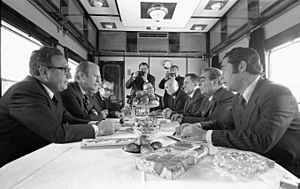
Andrei Gromyko was a very important figure during his lifetime. People had different opinions of him. Some were impressed by his diplomatic skills, while others found him serious and even boring. In 1981, The Times newspaper described him as "one of the most active and efficient members of the Soviet leadership. A man with an excellent memory, a keen intellect and extraordinary endurance."
His serious manner was noticeable from his early days in Washington and continued throughout his time as foreign minister. Ambassador Charles W. Yost, who worked with Gromyko, remembered him as "humorless" and looking "as though he was sucking a lemon." There's a story that when a reporter asked him if he enjoyed his breakfast, Gromyko simply replied, "Perhaps."
During his 28 years as foreign minister, Gromyko became the top expert on international diplomacy in the Soviet Union. Other diplomats respected his dedication to his work. Henry Kissinger once said, "If you can face Gromyko for one hour and survive, then you can begin to call yourself a diplomat." Gromyko's work influenced other Soviet and Russian ambassadors. Historians have said his main characteristic was his complete dedication to the interests of the state.
On 18 July 2009, Belarus celebrated the 100th anniversary of Gromyko's birth. People laid flowers at his statue in his hometown. A ceremony was held with his children, Anatoly and Emiliya. Exhibitions were opened in his honor, and a school and a street in Gomel were renamed after him.
Decorations and Awards
 Soviet Union:
Soviet Union:

 Hero of Socialist Labor, twice (1969, 1979)
Hero of Socialist Labor, twice (1969, 1979) Order of Lenin, seven times (1944, 1945, 1959, 1966, 1969, 1979, 1984)
Order of Lenin, seven times (1944, 1945, 1959, 1966, 1969, 1979, 1984) Order of the Patriotic War, 1st class (1985)
Order of the Patriotic War, 1st class (1985) Order of the Red Banner of Labour (1948)
Order of the Red Banner of Labour (1948) Order of the Badge of Honour (1954)
Order of the Badge of Honour (1954) Jubilee Medal "In Commemoration of the 100th Anniversary of the Birth of Vladimir Ilyich Lenin" (1969)
Jubilee Medal "In Commemoration of the 100th Anniversary of the Birth of Vladimir Ilyich Lenin" (1969) Jubilee Medal "Thirty Years of Victory in the Great Patriotic War 1941–1945" (1975)
Jubilee Medal "Thirty Years of Victory in the Great Patriotic War 1941–1945" (1975) Jubilee Medal "Forty Years of Victory in the Great Patriotic War 1941–1945" (1985)
Jubilee Medal "Forty Years of Victory in the Great Patriotic War 1941–1945" (1985) Medal "For Valiant Labour in the Great Patriotic War 1941–1945" (1945)
Medal "For Valiant Labour in the Great Patriotic War 1941–1945" (1945) Medal "Veteran of Labour" (1974)
Medal "Veteran of Labour" (1974) Jubilee Medal "70 Years of the Armed Forces of the USSR" (1988)
Jubilee Medal "70 Years of the Armed Forces of the USSR" (1988) Medal "In Commemoration of the 800th Anniversary of Moscow" (1947)
Medal "In Commemoration of the 800th Anniversary of Moscow" (1947) Lenin Prize (1982)
Lenin Prize (1982) USSR State Prize (1984)
USSR State Prize (1984)
- Other countries:
 Order of the Sun of Freedom (Afghanistan)
Order of the Sun of Freedom (Afghanistan) Order of Georgi Dimitrov (Bulgaria)
Order of Georgi Dimitrov (Bulgaria) Order of José Martí (Cuba)
Order of José Martí (Cuba) Order of Klement Gottwald (Czechoslovakia)
Order of Klement Gottwald (Czechoslovakia) Order of the Flag of the Republic of Hungary (Hungary)
Order of the Flag of the Republic of Hungary (Hungary) Order of Peace and Friendship (Hungary)
Order of Peace and Friendship (Hungary) Grand Cross of Order of the Sun of Peru (Peru)
Grand Cross of Order of the Sun of Peru (Peru) Order of Merit of the Polish People's Republic, 1st class (Poland)
Order of Merit of the Polish People's Republic, 1st class (Poland)
Images for kids
-
Gromyko standing between Harry Truman and James Byrnes at the Potsdam Conference in July 1945
See also
 In Spanish: Andréi Gromiko para niños
In Spanish: Andréi Gromiko para niños




